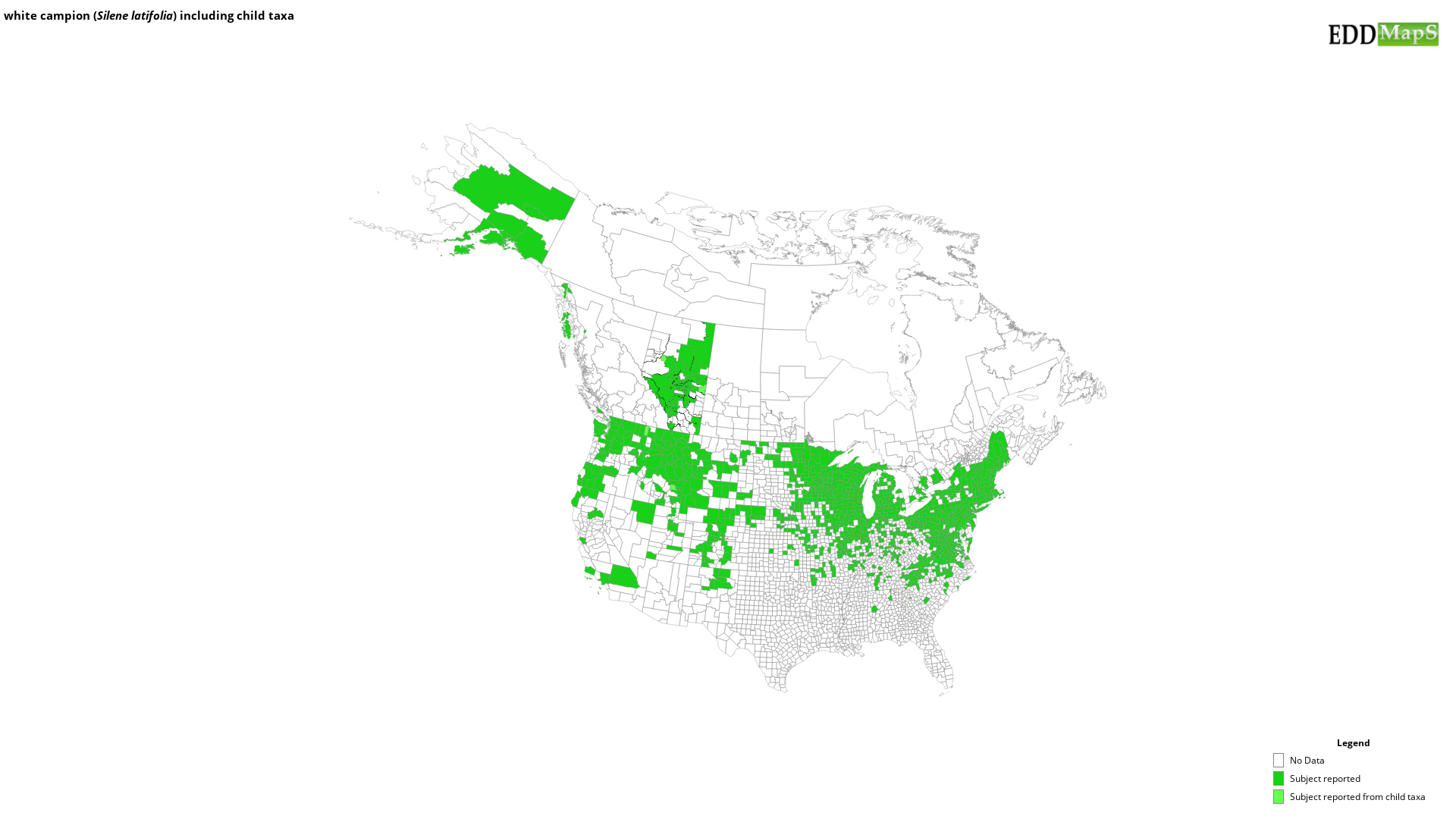white campion
(Silene latifolia)
This species is Introduced in the United States
Overview:
White cockle was introduced from Eurasia and is often confused with bladder campion (not hairy, not sticky) or night-flowering catchfly (hairy, upper stems sticky), white cockle is not sticky on any part of the plant. It is a short-lived perennial (sometimes biennial) native to Europe. Plants are either male or female, so not all plants produce seeds.
Habitat
White cockle prefers full sun and rich, well-drained soils. Hayfields are a frequent habitat of this invasive plant compounding the problem as weed seed gets distributed in baled forage.
Identification:
Stems: Stems are hairy, grow 30 to 120cm tall, and can be erect or spread laterally. There can be several stems per plant crowded plants branch in the upper stems. Stems are swollen at the nodes.
Leaves: Leaves are opposite, hairy, and lance or slightly oval-shaped with pointed tips. Basal leaves and upper stem leaves are smaller.
Flowers: Flowers are numerous, fragrant, and arranged in spreading clusters. The white (or pinkish) flowers have 5 notched petals and are only open in the evening. The sticky, tubular calyx surrounds the flower's base. The calyx of the male flower has 10 veins, and the female's 20 veins are longer and inflate with ripening.
Seed: The calyx matures into a fruit with 10 teeth at the tip containing many tiny, grayish seeds.
Prevention:
White cockle seeds are similar in size to clover and so are often a contaminant of forage seed.
Control:
White cockle can be a serious economic problem as its seeds are difficult to separate from alfalfa, clover and some grass crop seeds and this invader is an extremely heavy seed producer. This plant emerges in early spring, initially forms a taproot and next spreading lateral roots.
Grazing: Not grazed. Invasive plants should never be considered as forage.
Cultivation: Stem and root pieces can sprout to form new plants; therefore cultivation will usually spread an infestation.
Mechanical: Frequent mowing will reduce seed production.
Chemical: Mecoprop (in a product mix with 2,4-D and Dicamba) and Tribenuron-methyl (alone or in a product mix with Metsulfuron-methyl and quinchlorac) are registered for use on white cockle. Always check product labels to ensure the herbicide is registered for use on the target plant in Canada by the Pest Management Regulatory Agency. Always read and follow label directions. Consult your local Agricultural Fieldman or Certified Pesticide Dispenser for more information.
Biological: None researched to date.
Selected Images
Maps
EDDMapS Distribution - This map is incomplete and is based only on current site and county level reports made by experts, herbaria, and literature. For more information, visit www.eddmaps.org
Invasive Listing Sources
Taxonomic Rank
| Domain: Eukarya |
| Kingdom: Plantae |
| Phylum: Magnoliophyta |
| Class: Magnoliopsida |
| Superorder: Caryophyllanae |
| Order: Caryophyllales |
| Family: Caryophyllaceae |
| Subfamily: Caryophylloideae |
| Tribe: Sileneae |
| Genus: Silene |
| Silene latifolia |
Synonyms and Other Names
Other Common Names:
bladder campion
Related Scientific Names:
Silene alba (Mill.) E.H.L. Krause (Synonym)
References
Common Name Reference: Weed Science Society of America Common Names List
Scientific Name Reference: USDA, NRCS. 2010. The PLANTS Database. National Plant Data Center, Baton Rouge, LA, USA.

